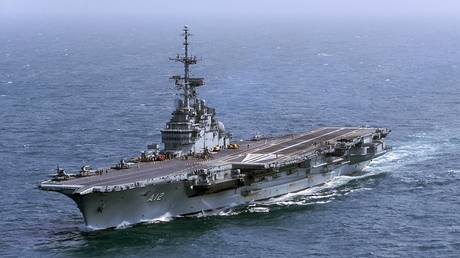
The act by the Brazilian Navy has prompted an outcry from environmentalists
Environmental groups have responded with anger after the Brazilian Navy sank its former flagship aircraft carrier in the Atlantic. The decommissioned ship was initially slated to be dismantled for scrap metal in Türkiye, but was refused entry.
The “planned and controlled sinking” of the 32,800-ton ‘Sao Paulo’ took place late in the afternoon on Friday, some 350km (217 miles) off the Brazilian coast at a depth of about 5,000 meters, according to a statement from the navy. The final resting place was selected with regard to the navigational, environmental, and economic aspects of such a move, it added.
The decision to scuttle the ship came after Turkish company Sok Denizcilik was authorized last year to scrap the vessel for metal, in what the Brazilian Defense Ministry called “an unprecedented attempt” to recycle it in a “safe and environmentally sound” manner.
However, after the start of the vessel’s transit, Türkiye blocked the procedure due to concerns from its environmental authorities. Brazil was forced to bring the carrier home, but did not allow it to enter port over the “high risk” to the environment.
With the ‘Sao Paulo’ facing the danger of spontaneously submerging due to buoyancy issues, the Defense Ministry said there was no other option than “jettisoning the hull, through the planned and controlled sinking.”
While Brazil sank the ship in a specially selected zone, the move drew the ire of environmental activists. In a statement on Saturday, NGO Basel Action Network said that the vessel contained some 760 tons of hazardous asbestos, and hundreds of tons of other toxic substances, including heavy metal-laden paint.
The organization asserted that the sinking “will no doubt contaminate the marine ecosystem in the dumpsite area for years to come.”
The ‘Sao Paulo’ was a Clemenceau-class aircraft carrier which was originally commissioned by the French Navy under name ‘Foch’ in 1963. The vessel, which could carry about 40 aircraft, was handed over to Brazil in 2000, becoming its new flagship. After being plagued by maintenance issues, the ‘Sao Paulo’ was decommissioned in 2017.




